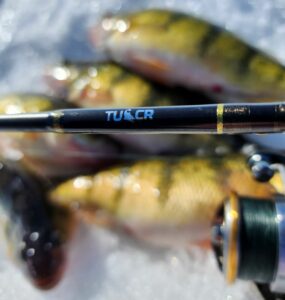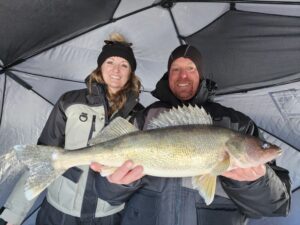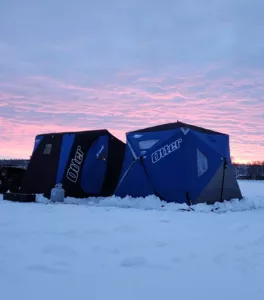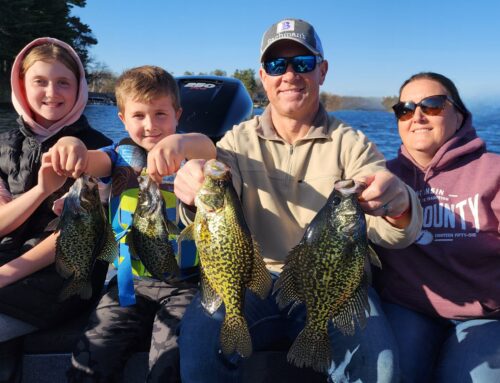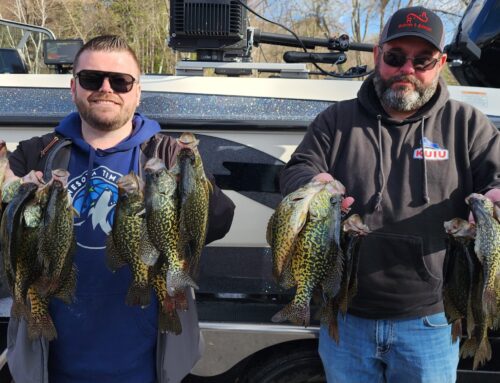How to Guide for Ice Fishing: Part III: November 21, 2023
Welcome back! If you missed last week, this is the third part of our ice fishing series. The Brainerd Lakes Area offers many year-round outdoor opportunities and ice fishing is definitely one of those great opportunities to get outdoors.
Electronics
Where do we start? Basically, you don’t need fishing electronics, lake maps (GPS positioning/depth contours), or underwater cameras to catch fish—and with that said—it’s a lot of fun to fish with them too! You can check depth with a heavy weight and fish the first break line you find, or you can look down a hole during daylight on a clear body of water and see what kind of cover you’re fishing on. Or there are electronic alternatives to those methods. Many anglers utilize a Vexilar, which in a basic sense shows the water column on a wheel when the sonar (or “puck”) is placed in the water via cable (just under the bottom of the ice), which depicts the bottom of the lake, the lure used by the angler and any potential approaching fish to detect when fish are near, as well as how they are responding to the lure. An underwater camera is a waterproof camera attached to a cable; anglers lower the camera into the water and view the video image on a screen, powered by a battery. And then there’s Garmin Livescope or “Forward Facing Sonar,” which is a real-time sonar allowing anglers to see what’s going on under the ice over 100ft away and 30+ft down; and when rotated, anglers can develop a mental image of what’s beneath them in 360 degrees of motion with only 1 hole drilled in the ice. Needless to say, this is an amazing tool, although expensive. Do these make you catch fish, no, though they can help decipher information while on ice.
- Basic: Vexilar FLX12
- Advanced: Garmin 93UHD2, Livescope LVS34 bundle, with Amped Outdoors lithium battery and Summit Fishing Equipment HD Shuttle/Pole system.
Shelters
Phew, that topic can go on for days, so let’s get into another big topic: ice fishing shelters! With the right outdoor gear/clothing, this is not necessarily a ‘must have’ piece of equipment, but it can make fishing really comfortable, and provide a solid barrier against those frigid Minnesota temperatures. Ice shelters range from portable “1-person” flip over shelters to “permanent” custom-made, multi-level cabins on the ice, and one thing is certain, it’s all about preference. Two common types of shelters include “flip over” and “hub” or “pop up” fish houses. A flip-over style shelter is a sled-style fish house, which converts into a fishing shelter by “flipping” the canvas or shelter material over the seating area. A hub style fish house is usually transported in a large duffel-like bag, and when assembled, “pops up” to form a roomy shelter. These tend to be lighter than the “flip-over” style though both shelters have pros and cons based on the functionality/design.
- Basic: Otter Vortex Pro Cabin (hub)
- Advanced: Otter XT Pro X Over Resort (flip)
Gear tips are purely opinions, though they are based on experiences and often tend to lean toward individuals’ preferences; keep this in mind when searching for gear and having your own experiences on ice. We will have a few more gear tips next week, then get into early ice tactics for species the Brainerd Lakes Area and Mille Lacs Minnesota!
Remember to look into Ice Safety Tips by the MN DNR regarding checking ice for safe travel! If you’re wondering where and how to fish, tune in to Visit Brainerd for weekly fishing reports by Hawg Hunterz Guide Service LLC! As always, have fun, stay safe and Happy Hawg Hunting!!
